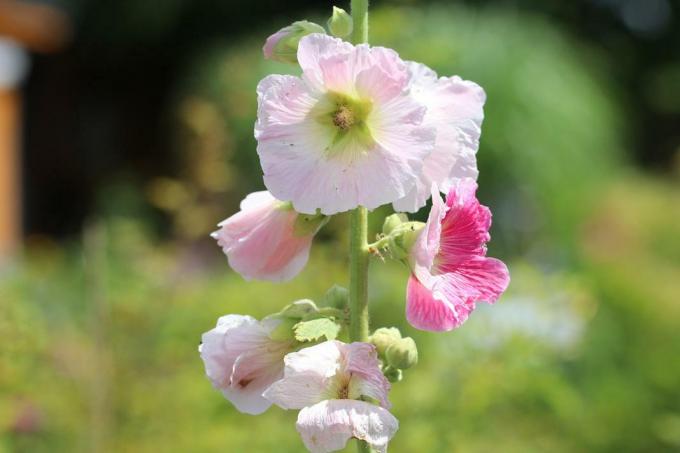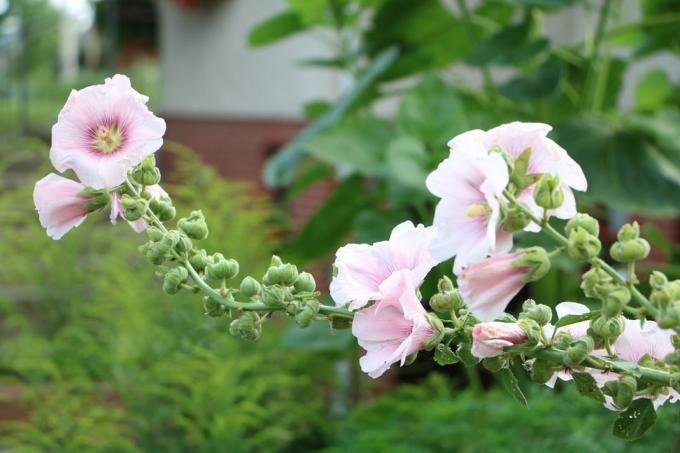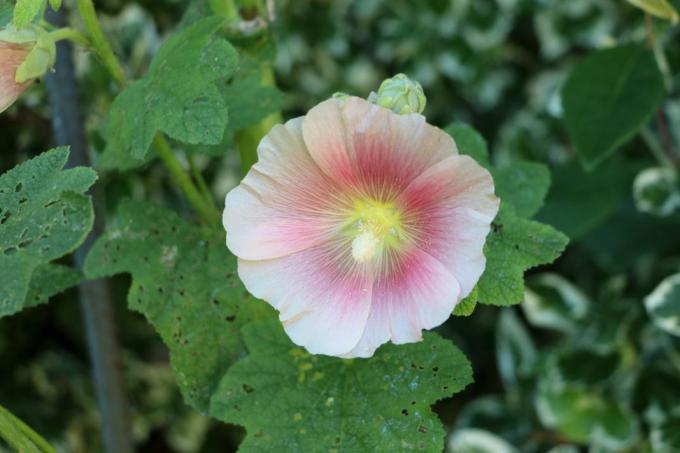
table of contents
- Origin, growth & flowering
- care
- Location
- plants
- to water
- Fertilize
- Cut
- Multiply
- Diseases
- Pests
Profile and care information open +conclude -
- Flower color
- multicolored, pink, violet, white
- Location
- Partial shade, sunny
- Heyday
- May, June, July, August, September
- Growth habit
- upright, perennial
- height
- up to 2 m
- Soil type
- loamy, gritty
- Soil moisture
- moderately dry, moderately moist
- PH value
- neutral
- Limescale tolerance
- Calcium tolerant
- humus
- rich in humus
- Poisonous
- no
- Plant families
- Mallow family, Malvaceae
- Plant species
- Ornamental plants
- Garden style
- Cottage garden
With its bright flowers, the Alcea rosea is an ornament for every garden. The height of the hollyhock makes it an eye-catcher. The perennial attracts attention with its oversized flowers in a wide variety of colors. It is also known under the name peasant rose or poplar mallow. In the summer bed, the sun worshiper ennobles every accompanying plant. With these care instructions you will find out what you should pay particular attention to.
Origin, growth & flowering
Like a candle, it stretches into the summer sky. The bowl-shaped flowers of Alcea rosea create a fantastic long-distance effect. It is beautiful to look at in cottage gardens. The two-year to perennial, winter-hardy hollyhock also stands out as a single plant. They bloom until September.
Alcea rosea begins as a small plant with deep green leaves to grow up to two meters high. When its blossoms break open, it shines in full splendor. With these care instructions you will learn how to get the most out of this plant.

The hollyhock comes from Eastern and Southern Europe as well as the Orient. In 1753 the genus Alcea was first published by Carl von Linné in Species Plantarum. Albert Spear Hitchcock and Jesse Robinson Green established Alcea rosea as a lectotype species in Standard-species of Linnaean Genera of Phaneogams in 1929.
The varieties of some species are cultivated in all subtropical and temperate areas of the world. However, the delimitation is often unclear. That is why other cultivated species often come under the name Alcea rosea.
care
The magnificent perennial is relatively undemanding. As a biennial plant, it does not develop its magnificent flowers until the second year. Follow the care instructions and make your wish for full bloom come true.
Location
The hollyhock likes it sunny in order to grow tall, healthy and strong. It can also find its way in partially shaded locations. She likes it sheltered from the wind. Because of its height, it needs safe cover. You should fix very tall plants. In sheltered beds and on the south side or on house walls, hollyhocks grow luxuriantly and with abundance of flowers.

Soil condition
For the floor, the imposing plants want:
- permeable, nutrient-rich soil
- Fresh and moist
- relaxed
- pH from 6.5 to 7.2
Look for a place where the soil doesn't dry out too much. With the addition of mulch you avoid that the soil becomes too firm. Mulch also keeps the nutrients in the soil. Provide regular moisture, but watch out for waterlogging, which damages the flowers.
Substrate
If you want to plant the hollyhocks yourself, almost any soil is suitable. But make sure that it has some humus. When planting, you can also incorporate this in the form of compost or potting soil. Commercially available high-quality potting soil is very suitable as a substrate. Occasional watering of the plants with pond water completes the nutrients. Nitrogen is best for the plant.
Planting time
The planting time for the hollyhock extends from spring to autumn. Once your perennials have settled in the garden, you can simply multiply them. After blooming, let the inflorescences stand and simply dry out. Rub the dry inflorescences with your hands, sprinkle the seeds in the bed and rake them under.

Sufficient small hollyhocks will develop by spring, which you can then isolate as you wish. The gardener is therefore not worried about the multiplication of the hollyhock.
plants
Plants in the bed
If you want to plant hollyhocks yourself, it is best to do so in spring. Although Alcea rosea does not make great demands on the soil, you should prepare the soil well. This includes thoroughly digging up the perennial bed in which the hollyhocks are to be planted. This helps loosen up and ventilate the soil well.
Hollyhocks form tap roots that want to penetrate the ground easily. You should also remove wild herbs, dried up roots and stones. Work in compost soil or good potting soil at the same time and add some gravel if necessary to make the soil more finely crumbly more permeable before planting.
The distance for the plants depends on the height of the plant. A distance of at least 50 centimeters is ideal. Quite large specimens want to stand as a solitary shrub, i.e. alone.
Here's how to go about planting:
- Dig plant pits at a distance of at least 50 cm to 90 cm
- If the soil is too heavy, add a layer of potting soil and some gravel
- Plant the hollyhock in such a way that the small root threads are not kinked
Press the earth lightly with your hands. Stale water is suitable for pouring on. A few horn shavings on the planting site also keep the soil loose.
Plants in the pot
When planting in a pot, you should make sure that the planter is large enough. The hollyhock grows very tall and should stand alone in the pot. For drainage, put a few potsherds over the opening in the bottom of the pot. There should be enough space in the pot or flower box to support the plant, such as a trellis. Pull in the support when the plant is about three feet tall. Note that a hollyhock does not develop flowers until its second year.
to water
The hollyhock does not like dry soil. In warm and dry summer months, it needs water every day. Give the water to the hollyhock from below so as not to damage the large flowers. Make absolutely sure that the irrigation water drains off well, so that the perennial does not stand unnecessarily in waterlogged soil. If Alcea rosea is in the pot, you should wait ten minutes for water to run through the soil into the saucer. Pour off the water. Water before the top layer of soil dries out.

Fertilize
Alcea rosea needs fertilizer from spring to full bloom. Their elixir of life is nitrogen. Rotted manure or liquid fertilizers in the irrigation water are suitable for the initial fertilization. When, how often and which fertilizer you use depends on the location.
Continue fertilizing as follows:
- Alcea rosea needs few nutrients in nutrient-rich soil
- after compost or uric acid in spring, a second dose in autumn is sufficient
- You should fertilize plants in the tub regularly
- fertilizer every two weeks is recommended
- this also applies to Alcea rosea on poor soil
As of September, the hollyhock, like many other perennials, no longer needs fertilizer.
Cut
You can cut back the plug rose immediately after flowering. In practice, this ensures a longer lifespan for the plant. Because in the following year the hollyhock will bloom more profusely and show numerous new flowers. The flowering period ends in September / October.
- When pruning, shorten the stems individually to about 10 centimeters
- You can also shorten the plant completely
- if you want to propagate your hollyhock, you can only cut after the seeds have ripened
- it is also possible to cut in early spring
It is important to use a sharp knife or sharp secateurs. Unclean cuts with unsuitable tools cause plant wounds. That weakens the plant. Pruning shears or rose shears are not best. If you want to prevent excessive seeding, remove dry inflorescences regularly.

Overwinter
You do not need to take any special precautions for wintering your hollyhocks in normal Central European winters. Alcea rosea is frost and winter hardy. For this reason, the perennial can overwinter directly in the garden in the perennial bed. Even young hollyhocks can do that, as they can get through the colder winter weeks without any problems.
Take care of your hollyhocks in the bucket. The container must be frost-proof here. Under no circumstances let the root ball of the perennial dry out during the winter. If the temperature is kept constant above 0 degrees Celsius, watering should be carried out regularly.
Small plants that have been grown in the house and planted out in autumn should be covered with brushwood. That protects them from the cold.
Multiply
Hollyhocks in the garden can be propagated in a very simple way. If you leave the inflorescences and do not worry about them, they will sow themselves and form numerous offshoots. In addition, Alcea rosea can be propagated in a very simple way:
sowing
Leave the inflorescences, the inconspicuous capsules that remain after flowering, in place and do not snap them off. The inflorescences dry out on the plant. In the fall, simply turn off the capsules that contain the seeds. Then rub these open with your hands and sprinkle the seeds on the perennial bed or where you want hollyhocks in the coming spring. Rake everything under easily. In the spring, many small peg roses appear on the spot. You can isolate these, for example on a plant every 50 centimeters.
Pay attention to the following:
- there are no flowers in the first year. The new plants only develop leaf rosettes
- in the following year after the frost, flower stalks and dreamlike mallow blossoms appear
- if old fruit clusters remain after blooming, Alcea rosea will be sown again
- every year there are new plants
Cuttings
By sowing in autumn you will get around 25 hollyhock seedlings per square meter in spring. You can plant the cuttings in March to April in the places where you want Alcea rosea in the future. To do this, carefully dig up the cuttings and place them in planting holes that are 50 to 90 centimeters apart. Incidentally, with the hollyhock it is not a problem to plant the cuttings straight away in the bed.

You can also prefer seeds in pots indoors over the winter. This is not absolutely necessary because the hollyhocks can do it directly in the bed. If you decide to do so, you can put the cuttings out in the spring, at the latest in May, as usual.
Diseases
Alcea rosea is susceptible to mallow rust. This is a fungal disease with red-brown pustules on the underside of the leaves. Small yellow spots form on top of the leaves. The fungus appears in spring and can overwinter in the plant itself. You should remove infected leaves in spring. Parts of the plants that have been cut down and cut back belong in the residual waste in autumn. Fungus in the early stages can be combated with approved antifungal agents (fungicides).
Pests
Lice or caterpillars
They can be easily read and the damaged leaves removed. If the infestation is too large, insecticides help.
Mallow flea
You can recognize it by the small feeding holes in the middle of the leaf if the leaf veins are intact. The beetle itself is black, blue, or green with red legs. Loosening the soil helps as a countermeasure is loosening the soil and watering it.
Snails
Snails especially eat the young leaves. Spread slug pellets in early spring.
Aphids
Nettle manure helps here. Chop up fresh nettle leaves, pour rainwater into the large container. Place in the sun for a few days, stirring daily. Spray on the leaves of the plant at a dilution of 1:10 in the morning. Alternatively, soapy water made from curd soap helps. Use 1 tablespoon of liquid curd soap for 1 liter of water. Also spray on the leaves in the morning.

